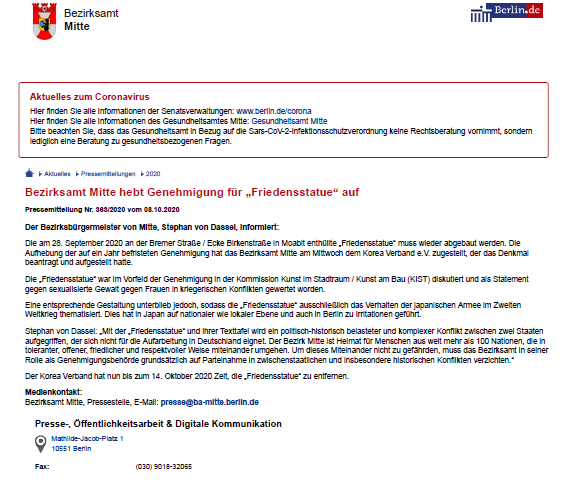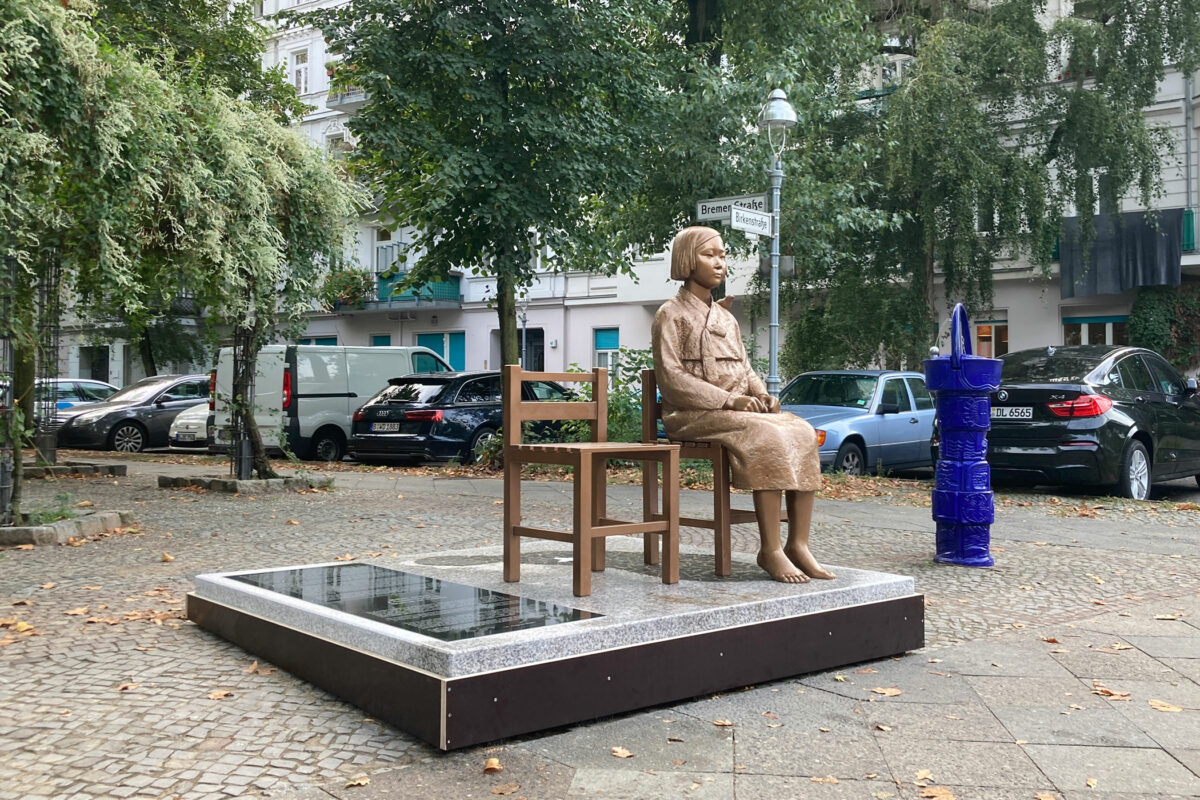ベルリン市ミッテ区 慰安婦像の許可取り消し決定
ベルリン公式サイトより
2020年10月8日
Bezirksamt Mitte hebt Genehmigung für „Friedensstatue“ auf
https://www.berlin.de/ba-mitte/aktuelles/pressemitteilungen/2020/pressemitteilung.1001656.php

ミッテ区役所は「平和像」の許可を取り消す
プレスリリース no.363/2020
2020年10月8日
ミッテ区長、シュテファン・フォン・ダッセル氏によると:
2020年9月28日、モアビット地区のブレーマー通りとビルケン通りの角に設置された「平和の像」 は撤去されなければならない。一年間の許可の取り消しをミッテ区役所は水曜日(10月7日)、像の許可を申請し建てたコリア協会に通告した。
この「平和の像」は、事前にアート アーバン スペース/ アート イン ビルディング委員会(KIST)で協議され、戦時紛争の女性に対する性暴力メッセージとして評定された。
しかし、提示された像「平和の像」は、第二次世界大戦における日本軍の行動のみをテーマにしており、充分にその(女性の性暴力に対するメッセージという)機能を果たせていない。この事が、日本において国及び地方レベルで、そしてベルリンでも苛立ちに繋がった。
ステファン・フォン・ダッセル(区長):「「平和の像」とその碑文では、政治的-歴史的に負担の課された2つの国家間の複雑な対立が取り上げられており、それをドイツで扱うのは適さない。このミッテ地区は、世界100か国以上からの人々が住む故郷(Heimat)であり、寛容で、オープンで、平和で、敬意溢れる事で互いに暮らしていけるのです。この一体感を危険に晒さないために、中立な承認機関としての役割を担う区役所は、2つの国家間の特に歴史的な紛争は避けなければならない。」
コリア協議会は現在、2020年10月14日までの期間内に「平和の像」を撤去しなければならない。
連絡先 : ミッテ区 プレス・オフィス
メールアドレス presse@ba-mitte.berlin.de
**********************************************************
【 原文ドイツ語 】
Bezirksamt Mitte hebt Genehmigung für „Friedensstatue“ auf
Der Bezirksbürgermeister von Mitte, Stephan von Dassel, informiert:
Die am 28. September 2020 an der Bremer Straße / Ecke Birkenstraße in Moabit enthüllte „Friedensstatue“ muss wieder abgebaut werden. Die Aufhebung der auf ein Jahr befristeten Genehmigung hat das Bezirksamt Mitte am Mittwoch dem Korea Verband e.V. zugestellt, der das Denkmal beantragt und aufgestellt hatte.
Die „Friedensstatue“ war im Vorfeld der Genehmigung in der Kommission Kunst im Stadtraum / Kunst am Bau (KIST) diskutiert und als Statement gegen sexualisierte Gewalt gegen Frauen in kriegerischen Konflikten gewertet worden.
Eine entsprechende Gestaltung unterblieb jedoch, sodass die „Friedensstatue“ ausschließlich das Verhalten der japanischen Armee im Zweiten Weltkrieg thematisiert. Dies hat in Japan auf nationaler wie lokaler Ebene und auch in Berlin zu Irritationen geführt.
Stephan von Dassel: „Mit der „Friedensstatue“ und ihrer Texttafel wird ein politisch-historisch belasteter und komplexer Konflikt zwischen zwei Staaten aufgegriffen, der sich nicht für die Aufarbeitung in Deutschland eignet. Der Bezirk Mitte ist Heimat für Menschen aus weit mehr als 100 Nationen, die in toleranter, offener, friedlicher und respektvoller Weise miteinander umgehen. Um dieses Miteinander nicht zu gefährden, muss das Bezirksamt in seiner Rolle als Genehmigungsbehörde grundsätzlich auf Parteinahme in zwischenstaatlichen und insbesondere historischen Konflikten verzichten.“
Der Korea Verband hat nun bis zum 14. Oktober 2020 Zeit, die „Friedensstatue“ zu entfernen.
Medienkontakt:
Bezirksamt Mitte, Pressestelle, E-Mail: presse@ba-mitte.berlin.de
**********************************************************
コリア協議会からの声明 2020年10月8日
Berlin will Mahnmal gegen sexualisierte Kriegsgewalt gegen Frauen entfernen lassen
(ベルリンが女性への性暴力に反対する記念の撤去を要請)
https://www.koreaverband.de/blog/2020/10/08/stellungnahme-friedensstatue/
**********************************************************
ベルリン、ミッテ区 関係各所 コンタクト先 まとめ
慰安婦像許可取り消しの決定への支持、お礼を伝えてたい方、以下参考にしてください。
【 ベルリン州 公式サイト より コンタクト情報 】
Der Regierende Bürgermeister von Berlin
Senatskanzlei
Michael Müller
メールアドレス
Der-Regierende-Buergermeister@senatskanzlei.berlin.de
住所
Berliner Rathaus
Jüdenstr. 1
10178 Berlin
Tel.: (030) 9026-0 Fax: (030) 9026-2013
◆文化とヨーロッパのための議会事務局(Senatsverwaltung für Kultur und Europa)文化部門 (Abteilung Kultur)
議長(Referatsleiter)Helge Rehders
メールアドレス
helge.rehders@kultur.berlin.de
住所
Brunnenstr. 188-190
10119 Berlin
※ ベルリン公式サイトから 慰安婦像設置のお知らせ
Berlin bekommt auch die weltbekannte Friedensstatue!
(ベルリン 世界的に有名な平和像を設置!)
※リンク切れ 保存PDF
**********************************************************
【 慰安婦像が設置された ベルリン ミッテ地区 の 区長・議員、他コンタクト情報 】
◆区長(Der Bezirksbürgermeister)
Stephan von Dassel(シュテファン フォン ダッセル)
メールアドレス
bezirksbuergermeister@ba-mitte.berlin.de
住所
Mathilde-Jacob-Platz 1
10551 Berlin
Germany
Tel.: (030) 9018-32200 Fax: (030) 9018-32101
◆Bezirksamt Mitte (ミッテ区役所)
Fachbereich Kunst, Kultur und Geschichte(芸術、カルチャー、歴史専門)
Fachbereichsleitung (担当室長)
Dr. Ute Müller-Tischler (Dr.ウテ・ミュラー-ティシュラー)
※除幕式に出席
メールアドレス
ute.mueller-tischler@kultur-mitte.de
住所
Mathilde-Jacob-Platz 1
10551 Berlin
Tel.: (030) 9018-33408
◆ Bezirksstadträtin(区議)Sabine Weißler
※慰安婦像除幕式でスピーチ予定だったが出席せず
メールアドレス
sabine.weissler@ba-mitte.berlin.de
住所
Mathilde-Jacob-Platz 1
10551 Berlin
Tel.: (030) 9018-33500 Fax: (030) 9018-33509
◆ Bezirksstadträtin(区議) Ephraim Gothe
メールアドレス
ephraim.gothe@ba-mitte.berlin.de
住所
Rathaus Wedding
Müllerstr. 146
13353 Berlin
Tel.: (030) 9018-44600 Fax: (030) 9018-44646
◆ Bezirksstadträtin(区議) Ramona Reiser
メールアドレス
ramona.reiser@ba-mitte.berlin.de
住所
Rathaus Mitte
Karl-Marx-Allee 31
10178 Berlin
Tel.: (030) 9018-23700 Fax: (030) 9018-23498
◆ Bezirksstadträtin(区議) Carsten Spallek
メールアドレス
schulstadtrat@ba-mitte.berlin.de
住所
Rathaus Tiergarten
Mathilde-Jacob-Platz 1
10551 Berlin
Tel.: (030) 9018-33900 Fax: (030) 9018-33910
◆ ミッテ 地区役所 (Bezirksamt Mitte von Berlin)
メールアドレス
buergeramt@ba-mitte.berlin.de
住所
Bezirksamt Mitte von Berlin
13341 Berlin (Postanschrift)
Tel.: (030) 9018-20 Fax: (030) 9018- 32010
◆ ミッテ区 プレス・オフィス ( Bezirksamt Mitte, Pressestelle )
メールアドレス presse@ba-mitte.berlin.de
◆ ミッテ地区 twitter
Bezirksamt Mitte @BA_Mitte_Berlin
https://twitter.com/BA_Mitte_Berlin
**********************************************************
【 日独友好姉妹都市 】
<ベルリン州>
◆ 東京
姉妹友好都市 https://www.seisakukikaku.metro.tokyo.lg.jp/diplomacy/city-to-city-diplomacy/
外務部管理課
メールアドレス S0000573@section.metro.tokyo.jp
tel: 03-5388-2222 fax: 03-5388-1215
<ベルリン・ミッテ区>
◆ 東京都 新宿区
新宿区の友好都市 https://www.city.shinjuku.lg.jp/kanko/file02_00008.html
地域振興部多文化共生推進課
tel: 03-3209-9999 fax: 03-3209-9900
意見フォーム https://www.faq.city.shinjuku.lg.jp/op/opinioninput.aspx
◆ 大阪府 東大阪市
姉妹都市の紹介について https://www.city.higashiosaka.lg.jp/0000003395.html
都市魅力産業スポーツ部 国際観光室
tel: 06(4309)3230 fax: 06(4309)3849
問い合わせフォーム https://bit.ly/36iJTr3
※米国で最初に像が立った加州グレンデール市も姉妹都市
◆ 島根県 津和野町 http://www.tsuwano.net/
商工観光課 kankou@town.tsuwano.lg.jp
tel: 0856-72-0652 fax: 0856-72-1650
津和野町教育委員会 kyouiku@town.tsuwano.lg.jp
tel :0856-72-1854 fax :0856-72-1650
※参照サイト
日独姉妹都市・友好都市-西日本
日独交流150周年
**********************************************************
◆ 外務省 御意見・御感想
外務省では,外交政策や外務省の業務に関する皆様の御意見を幅広く受け付けています。
https://www.contact.mofa.go.jp/form/pub/mofaj/feedback
◆ 在ドイツ日本大使館
在ドイツ連邦共和国特命全権大使 柳 秀直 (2020.11交代/前任:八木毅)
<連絡先>
メールアドレス: japanese-info@bo.mofa.go.jp
郵送住所:
Botschaft von Japan
Hiroshimastraße 6
10785 Berlin
Tel.: (030) 210 94-0 Fax: (030) 210 94-222
**********************************************************
















